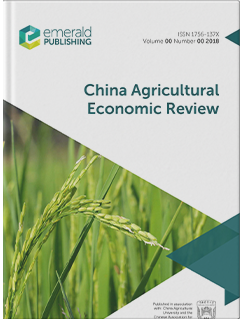Exploring the relationship between plot size and fertilizer use efficiency: evidence from large-scale farming in China
IF 4.6
2区 经济学
Q1 AGRICULTURAL ECONOMICS & POLICY
引用次数: 1
Abstract
PurposeThis paper investigates the relationship between plot size and fertilizer use efficiency (FE) in Chinese large-scale farming and searches for the underlying mechanisms that explain this relationship.Design/methodology/approachBased on a household- and plot-level data set of large-scale production units (LSPUs) from Jiangsu and Jiangxi Provinces, the technical and fertilizer use efficiency of large-scale rice production is estimated by applying a translog stochastic frontier production function. The authors impose a monotonicity condition on the translog frontier using a three-step procedure to get theoretically consistent efficiency estimates. A beta regression model is then used to explore the association between plot size and LSPUs' efficiency in fertilizer application.FindingsThe average FE for the sampled plots is around 30%, which shows a large potential for LSPUs to reduce fertilizer use. A U-shaped relationship is observed between plot size and FE. The authors relate this non-linear pattern to the substitution of labour with capital-intensive technology and the efficiency differences in terms of farming performance between family and hired workers.Originality/valueFirst, according to the authors’ knowledge, this paper is a first attempt to study the size–efficiency relationship focussing on fertilization practices of large-scale farming. The second contribution lies in the large-scale ranges of the plot-level data set. Third, efforts are made to reveal the mechanisms determining the plot size–FE relationship. Fourth, the authors provide guiding evidence for policymaking, as they show that the size of individual plots deserves equal attention in land consolidation decisions. Methodologically, this paper improves existing estimates of single-factor technical efficiency issued from a restricted production frontier model.探索地块大小与肥料利用效率的关系——来自中国大规模农业的证据
目的研究中国规模农业中小区面积与肥料利用效率之间的关系,并寻找解释这种关系的潜在机制。设计/方法论/方法基于江苏和江西两省大型生产单位的家庭和小区级数据集,应用translog随机前沿生产函数估计了大型水稻生产的技术和肥料利用效率。作者使用三步程序在translog边界上施加单调性条件,以获得理论上一致的效率估计。然后使用β回归模型来探索小区大小与LSPU施肥效率之间的关系。发现采样地块的平均FE约为30%,这表明LSPU在减少化肥使用方面有很大潜力。在地块大小和FE之间观察到U形关系。作者将这种非线性模式与资本密集型技术对劳动力的替代以及家庭和雇佣工人在农业表现方面的效率差异联系起来。原创性/价值首先,根据作者的知识,本文首次尝试研究大规模农业施肥实践中的规模-效率关系。第二个贡献在于绘图级别数据集的大范围。第三,努力揭示决定地块大小-FE关系的机制。第四,作者为政策制定提供了指导性证据,因为他们表明,在土地整理决策中,个别地块的大小值得同等关注。在方法论上,本文改进了现有的限制生产前沿模型对单因素技术效率的估计。
本文章由计算机程序翻译,如有差异,请以英文原文为准。
求助全文
约1分钟内获得全文
求助全文
来源期刊

China Agricultural Economic Review
AGRICULTURAL ECONOMICS & POLICY-
CiteScore
9.80
自引率
5.90%
发文量
41
审稿时长
>12 weeks
期刊介绍:
Published in association with China Agricultural University and the Chinese Association for Agricultural Economics, China Agricultural Economic Review publishes academic writings by international scholars, and particularly encourages empirical work that can be replicated and extended by others; and research articles that employ econometric and statistical hypothesis testing, optimization and simulation models. The journal aims to publish research which can be applied to China’s agricultural and rural policy-making process, the development of the agricultural economics discipline and to developing countries hoping to learn from China’s agricultural and rural development.
 求助内容:
求助内容: 应助结果提醒方式:
应助结果提醒方式:


